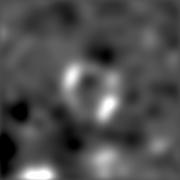| Observation data Epoch J2000 Equinox J2000 | |
|---|---|
| Constellation | Cygnus |
| Right ascension | 20h 31m 42.2847s[1] |
| Declination | +40° 21′ 59.0744″[1] |
| Apparent magnitude (V) | 15.1[2] |
| Characteristics | |
| Spectral type | B:I[e][3] |
| Astrometry | |
| Radial velocity (Rv) | 39.02±7.30[1] km/s |
| Proper motion (μ) | RA: −2.925[1] mas/yr Dec.: −5.339[1] mas/yr |
| Parallax (π) | 0.5725 ± 0.0596 mas[1] |
| Distance | approx. 5,700 ly (approx. 1,700 pc) |
| Absolute magnitude (MV) | −10[4] |
| Details | |
| Luminosity | 2.51×105[5] L☉ |
| Temperature | 20,400[5] K |
| Other designations | |
| Database references | |
| SIMBAD | data |
G79.29+0.46 is a luminous blue variable star candidate located in the Cygnus X star formation region.[1][5] In the infrared and at radio wavelengths a prominent circular nebula can be seen. This nebula was formed by past mass-loss episodes of the LBV candidate.[6]
G79.29+0.46 was first reported as a suspected LBV by Higgs, Wendker & Landecker in 1993 with the DRAO Synthesis Telescope, which identified a nebula around a star that was a wind-blown shell.[7] As an LBV candidate, it has a spectrum with many emission lines, H-alpha being the strongest. The spectrum is similar to other LBVs and Be supergiants. The strength of the H-alpha line suggest very dense winds around this star.[3] The star is currently losing mass at a rate of 1.4×10−6 M☉/year and it is surrounded by a dusty envelope with a temperature of 40 to 1,200 K.[5] The star is considered only a candidate LBV because it has not shown variability in the optical or near-infrared over 20 years. It has been suggested that it is a LBV in the quiescent stage.[5]
From radio and infrared images a detached shell can be seen that shows evidence of two mass-loss episodes.[6] This shell has a mass of 1.51 M☉ and a radius of 0.66 parsecs,[5] and it contains carbon monoxide[8] and ammonia.[6]
Gallery
-
Spitzer and WISE view of G79.29+0.46, the H II-region DR15 (bright object lower left) and the IRDC G79.3+0.3 (dark clouds)[6]
-
The outer shell is best seen between 20 and 70 Microns, here an image by Spitzer and Herschel.
-
Radio image of G79.29+0.46 at 1.4 GHz
References
- ^ a b c d e f g Gaia Collaboration (2022-05-01). "VizieR Online Data Catalog: Gaia DR3 Part 1. Main source (Gaia Collaboration, 2022)". VizieR Online Data Catalog: I/355. Bibcode:2022yCat.1355....0G.
- ^ Kohoutek, L.; Wehmeyer, R. (1997). "Catalogue of stars in the Northern Milky Way having H-alpha in emission". Astronomische Abhandlungen der Hamburger Sternwarte. 11: 1. Bibcode:1997AAHam..11.....K.
- ^ a b Voors, R. H. M.; Geballe, T. R.; Waters, L. B. F. M.; Najarro, F.; Lamers, H. J. G. L. M. (2000-10-01). "Spectroscopy of the candidate luminous blue variable at the center of the ring nebula G79.29+0.46". Astronomy and Astrophysics. 362: 236–244. arXiv:astro-ph/0008293. Bibcode:2000A&A...362..236V. ISSN 0004-6361.
- ^ Higgs, L. A.; Wendker, H. J.; Landecker, T. L. (1994-11-01). "G 79.29+0.46: a young stellar-wind shell in Cygnus X.". Astronomy and Astrophysics. 291: 295–309. Bibcode:1994A&A...291..295H. ISSN 0004-6361.
- ^ a b c d e f Agliozzo, C.; Noriega-Crespo, A.; Umana, G.; Flagey, N.; Buemi, C.; Ingallinera, A.; Trigilio, C.; Leto, P. (2014-05-01). "The candidate luminous blue variable G79.29+0.46: a comprehensive study of its ejecta through a multiwavelength analysis". Monthly Notices of the Royal Astronomical Society. 440 (2): 1391–1409. arXiv:1402.2983. Bibcode:2014MNRAS.440.1391A. doi:10.1093/mnras/stu296. ISSN 0035-8711.
- ^ a b c d Rizzo, J. R.; Palau, Aina; Jiménez-Esteban, F.; Henkel, C. (2014-04-01). "Ammonia observations in the LBV nebula G79.29+0.46. Discovery of a cold ring and some warm spots". Astronomy and Astrophysics. 564: A21. arXiv:1401.6186. Bibcode:2014A&A...564A..21R. doi:10.1051/0004-6361/201323170. ISSN 0004-6361. S2CID 119246133.
- ^ Higgs, L. A.; Wendker, H. J.; Landecker, T. L. (1993). "Discovery of a Young Stellar-Wind Shell in Cygnus X". American Astronomical Society Meeting Abstracts. 183. Bibcode:1993AAS...183.5801H.
- ^ Rizzo, J. R.; Jiménez-Esteban, F. M.; Ortiz, E. (2008-07-01). "Discovery of Warm and Dense Molecular Gas Surrounding the Ring Nebula G79.29+0.46". The Astrophysical Journal. 681 (1): 355–364. arXiv:0804.0266. Bibcode:2008ApJ...681..355R. doi:10.1086/588455. ISSN 0004-637X. S2CID 17847585.


![Spitzer and WISE view of G79.29+0.46, the H II-region DR15 (bright object lower left) and the IRDC G79.3+0.3 (dark clouds)[6]](http://upload.wikimedia.org/wikipedia/commons/thumb/6/6f/G79.29%2B0.46.png/180px-G79.29%2B0.46.png)

